ASUS X72D/K72DR: Three Cores, No Waiting
by Dustin Sklavos on October 25, 2010 12:01 AM ESTGaming on the X72D
Given the—let's be generous and say "humble"—ATI Mobility Radeon HD 5470 the ASUS X72D hands the heavy-lifting off to, we're not expecting miracles and as such have chosen our test suite accordingly. For the 5470 we're using our "Low" preset, but because the X72D is a 17" notebook with a 1600x900 screen, we've tested at that resolution as well. The 750MHz core clock on the 5470 means this is about as fast as this GPU is going to get, but you'll see that's not quite enough for gaming at 1366x768 and nowhere near enough for gaming at 1600x900.
First, our 3DMark benches.

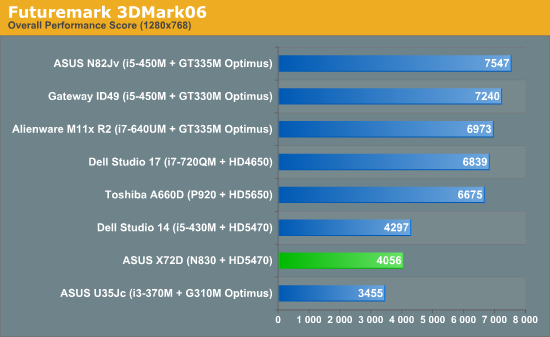
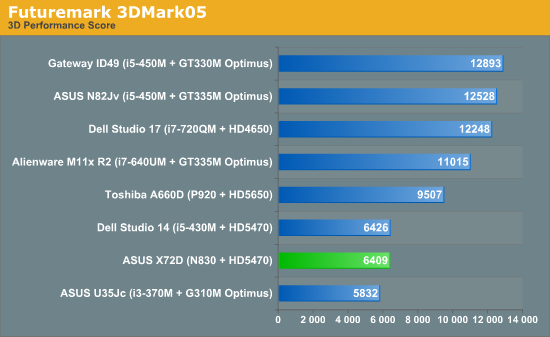

In some cases, the 5470 seems to be limited by the Phenom II; the Studio 14 has a slower core clock on the GPU but a much faster processor, making most of the results a wash.
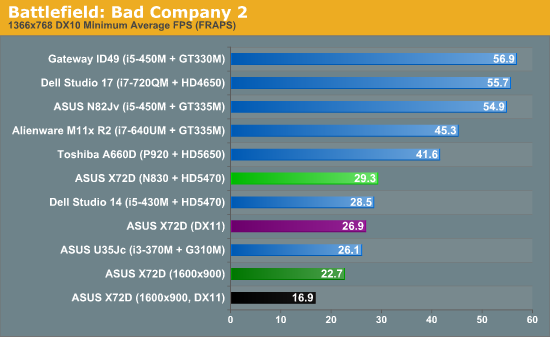
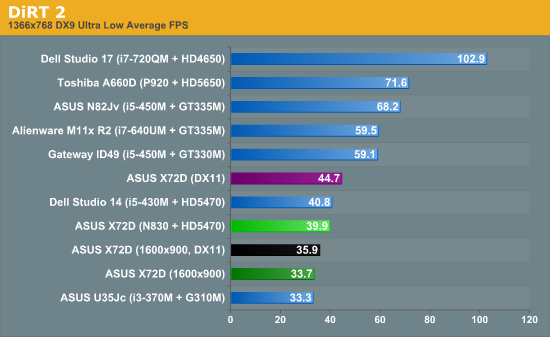
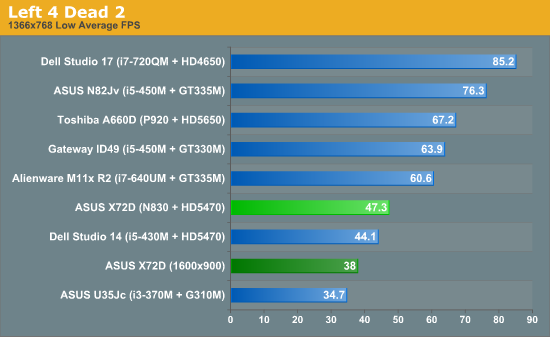

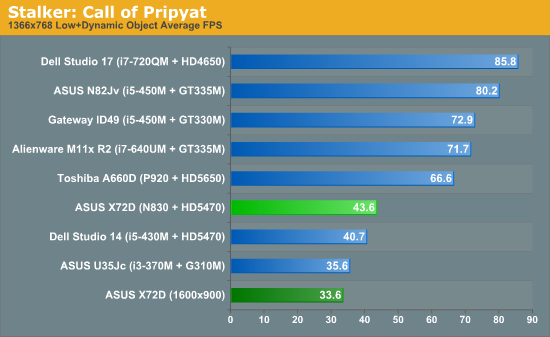
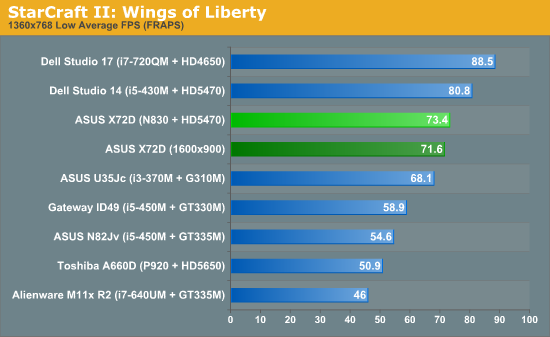
Well, the 5470 can game, sort of. StarCraft II generally cedes victory to the Radeons at Low assuming no major CPU bottlenecks (like, say, a 1.6 GHz quad core Phenom II), so no surprises there. But keep in mind these settings are pretty much as low as these games can go, and frankly StarCraft II looks horrible at these settings—imagine the original game, in 3D, but with textures from 10 years back and you get the idea. The Mobility Radeon HD 5470 is still miles away from catching up with mainstream class GPUs, though. It picks on the GeForce G 310M pretty liberally, but that's like winning a race with a three-legged horse because the other competitors are dead.
Which raises the same complaints we had when we reviewed the U35Jc and the GeForce G 310M: entry-level GPUs are terrible, offering little value over integrated options. On the X72D, this problem is made more egregious by three things: first, as I've mentioned before, the Radeon HD 5470 is a joke on any platform. Our next generation part has the same number of shaders as its predecessor, and worse, because of DirectX 11 support those shaders are actually slower. So in practice, the difference between the 5470 and last generation's Mobility Radeon HD 4570 is like night and night. But wait, there's more!
The X72D is using AMD's RS880 chipset, which means it already had perfectly serviceable integrated graphics to begin with in the form of the Radeon HD 4290. Since the 5470 just doesn't offer enough gaming performance to merit its inclusion over the IGP (let alone its existence), it's difficult to figure out why it's even here. The 5470 isn't capable of better Blu-ray playback than the 4290—okay, it can bitstream HD audio, but otherwise they're equal—so that's no justification either.
And finally, this is a 17" notebook. In a chassis this size, there's just no reason not to include a Mobility Radeon HD 5650, especially when Acer is happy to offer one in a competing notebook at just $699. The Acer Aspire AS7551G may have one of the worst keyboards on the market and be missing a Blu-ray drive, but in terms of gaming performance it's a far better deal. If Acer can hit that price point, there's no reason ASUS couldn't put a 5650 in the X72D.










37 Comments
View All Comments
debacol - Tuesday, October 26, 2010 - link
Except it isn't useful. The i3 compares to it in performance yet destroys it in battery life. Plus you can get a similar laptop with an i3 in it for cheaper than this. I'm really hoping bobcat competes, because Intel has completely mopped the floor with AMD in the mobile sector.Malih - Tuesday, October 26, 2010 - link
+1this cries for Zacate, I'm on the market for 12"/13" new notebook right now, but until Zacate is released and reviewed here on AT i'm not gonna make any decision, my 3 years old 12" acer 2920z will still be around.
xxtypersxx - Monday, October 25, 2010 - link
Holy thermals, that is high for even an intel chip and all the guidance I have ever seen with AMD's 45nm chips reccomends 60-70C as the top end.blackshard - Tuesday, October 26, 2010 - link
60-70°C are reccomendations for desktop chips.mobile chips have far higher tolerances (up to 100°C and more).
mino - Monday, October 25, 2010 - link
Reasons for 5470 to exist:1) Crappy/incompatible Intel IGP drivers (counts for Intel platform)
2) 3x the performance of IGP's (RS880/Arrandale)
3) Hybrid Crossfire anyone ??? You mention the uselessness of IGP and yet you not even bother mentioning whether Hybrid crossfire id available ...
Sorry Dustin, but your bashing of HD5470 is just a spoiled kid's talk not worth of this site.
This issue aside, thanks for an interesting revue.
JarredWalton - Monday, October 25, 2010 - link
Take your comments in light of the laptop being reviewed and you'll see the problem. Intel IGP is a different platform, 3x slow is still slow, and ASUS didn't use Hybrid CrossFire--or switchable graphics. The bigger problem is that there's just not much utility in these low-end parts anymore.If you were talking about the old Core 2 GMA 4500MHD IGP, I'd give you point one, but the Intel HD Graphics has had very few problems, particularly with the latest drivers. It is, as far as I'm concerned, essentially equal to the HD 4200 IGP. Yes, there are a few areas where I'd give the 4200 the edge, but for casual users it just doesn't matter. It can handle HD video (including YouTube HD), and even if you wanted to argue about audio bitstreaming capabilities Intel can do DTS-HD and DD TrueHD if I'm not mistaken (though it may require getting a setup with proper BIOS support).
Anyway, I'll give you the existence of the HD 5470 as something the market wants, but when we say "the market" I think we all understand that it really means "big OEMs like Dell and HP". Any consumer that knows their stuff understands that entry-level discrete graphics chips are a joke. The "midrange" stuff only costs a bit more, typically doubles performance and allows improved quality, and it doesn't even use that much more power. If you have switchable graphics thrown in, then there's really no reason to bother with 5470.
NVIDIA's GT 415M looks to be more like a low-end 5650 competitor based on the specs, so hopefully the next-gen AMD mobile parts will finally move beyond the pathetic 80 Stream Processor mark. That's our real complaint: IGP = 40 SP, entry dGPU = 80 SP, midrange GPU = 400 SP. That's a major jump in shader capabilities.
Dustin Sklavos - Monday, October 25, 2010 - link
Jarred covered me but I'd like to point out...we haven't had Hybrid Crossfire since the 3400 series.BaronMatrix - Monday, October 25, 2010 - link
If you notice the Asus i7 has an 84Wh battery where the AMD has a 48Wh battery.JarredWalton - Tuesday, October 26, 2010 - link
Which is why we have the "relative battery life" chart.orionmgomg - Tuesday, October 26, 2010 - link
http://www.newegg.com/Product/Product.aspx?Item=N8...about 1,000$
I would say a little too high for this computer.
For 1000 you can get a better set up, or better hardware (better GPU) and performance
I dont understand why you did not have a price chart necx to overall performance chart - that way you could clearly see what you get for your money, system to system,
but oh well - hooray for AMD and their ability to get any traction in the laptop marketshare catagory